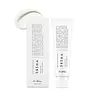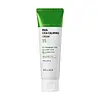What's inside
What's inside
 Key Ingredients
Key Ingredients

 Benefits
Benefits

 Concerns
Concerns

 Ingredients Side-by-side
Ingredients Side-by-side

Water
Skin ConditioningPropanediol
SolventGlycerin
HumectantCyclohexasiloxane
Emollient1,2-Hexanediol
Skin ConditioningCaprylic/Capric Triglyceride
MaskingDicaprylyl Carbonate
EmollientPolyglycerin-3
HumectantPolyglyceryl-10 Stearate
Skin ConditioningHydrogenated Polydecene
EmollientLaminaria Japonica Extract
Skin ProtectingEclipta Prostrata Leaf Extract
Skin ConditioningOenothera Biennis Flower Extract
AstringentPerilla Ocymoides Leaf Extract
TonicLavandula Angustifolia Flower Extract
CleansingSargassum Fulvellum Extract
Skin ConditioningCentella Asiatica Leaf Extract
Skin ConditioningGardenia Florida Fruit Extract
Skin ConditioningCalendula Officinalis Flower Extract
MaskingMelia Azadirachta Flower Extract
Skin ConditioningHouttuynia Cordata Extract
Skin ConditioningMelia Azadirachta Leaf Extract
Skin ConditioningCurcuma Longa Root Extract
MaskingOcimum Sanctum Leaf Extract
Skin ConditioningAgave Tequilana Leaf Extract
AstringentCorallina Officinalis Extract
Skin ConditioningHibiscus Sabdariffa Flower Extract
Skin ConditioningSodium Hyaluronate
HumectantHydrogenated Lecithin
EmulsifyingPelargonium Graveolens Flower Oil
MaskingEmpetrum Nigrum Fruit Juice
Skin ConditioningAmmonium Acryloyldimethyltaurate/Vp Copolymer
C14-22 Alcohols
Emulsion StabilisingC12-20 Alkyl Glucoside
EmulsifyingAcrylates/C10-30 Alkyl Acrylate Crosspolymer
Emulsion StabilisingButylene Glycol
HumectantPolyquaternium-51
Skin ConditioningTromethamine
BufferingFructooligosaccharides
HumectantAdenosine
Skin ConditioningBeta-Glucan
Skin ConditioningGlycine Soja Sterols
EmollientHydrolyzed Hyaluronic Acid
HumectantResveratrol
AntioxidantGlucose
HumectantOligopeptide-1
Skin ConditioningCeramide NP
Skin ConditioningPEG-40 Castor Oil
EmulsifyingEthylhexylglycerin
Skin ConditioningCitronellol
PerfumingGeraniol
PerfumingLinalool
PerfumingWater, Propanediol, Glycerin, Cyclohexasiloxane, 1,2-Hexanediol, Caprylic/Capric Triglyceride, Dicaprylyl Carbonate, Polyglycerin-3, Polyglyceryl-10 Stearate, Hydrogenated Polydecene, Laminaria Japonica Extract, Eclipta Prostrata Leaf Extract, Oenothera Biennis Flower Extract, Perilla Ocymoides Leaf Extract, Lavandula Angustifolia Flower Extract, Sargassum Fulvellum Extract, Centella Asiatica Leaf Extract, Gardenia Florida Fruit Extract, Calendula Officinalis Flower Extract, Melia Azadirachta Flower Extract, Houttuynia Cordata Extract, Melia Azadirachta Leaf Extract, Curcuma Longa Root Extract, Ocimum Sanctum Leaf Extract, Agave Tequilana Leaf Extract, Corallina Officinalis Extract, Hibiscus Sabdariffa Flower Extract, Sodium Hyaluronate, Hydrogenated Lecithin, Pelargonium Graveolens Flower Oil, Empetrum Nigrum Fruit Juice, Ammonium Acryloyldimethyltaurate/Vp Copolymer, C14-22 Alcohols, C12-20 Alkyl Glucoside, Acrylates/C10-30 Alkyl Acrylate Crosspolymer, Butylene Glycol, Polyquaternium-51, Tromethamine, Fructooligosaccharides, Adenosine, Beta-Glucan, Glycine Soja Sterols, Hydrolyzed Hyaluronic Acid, Resveratrol, Glucose, Oligopeptide-1, Ceramide NP, PEG-40 Castor Oil, Ethylhexylglycerin, Citronellol, Geraniol, Linalool
Water
Skin ConditioningGlycerin
HumectantCaprylic/Capric Triglyceride
MaskingButylene Glycol
HumectantCetearyl Alcohol
EmollientIsotridecyl Isononanoate
EmollientDicaprylyl Ether
Emollient1,2-Hexanediol
Skin ConditioningPentylene Glycol
Skin ConditioningChlorella Vulgaris Extract
Skin ConditioningHydrolyzed Corn Starch
HumectantLactobacillus Ferment
Skin ConditioningSodium Hyaluronate
HumectantCentella Asiatica Leaf Extract
Skin ConditioningDiglycerin
HumectantPolyglyceryl-3 Methylglucose Distearate
EmulsifyingVinyldimethicone
Hydroxyethyl Acrylate/Sodium Acryloyldimethyl Taurate Copolymer
Emulsion StabilisingCetearyl Olivate
Sorbitan Olivate
EmulsifyingPanthenol
Skin ConditioningGlucose
HumectantDiisostearyl Malate
EmollientFructooligosaccharides
HumectantFructose
HumectantSodium Polyacryloyldimethyl Taurate
Emulsion StabilisingPalmitic Acid
EmollientDipropylene Glycol
HumectantStearic Acid
CleansingHydrogenated Polydecene
EmollientEthylhexylglycerin
Skin ConditioningCaprylyl Glycol
EmollientDipotassium Glycyrrhizate
HumectantAdenosine
Skin ConditioningSorbitan Isostearate
EmulsifyingPolyglyceryl-10 Laurate
Skin ConditioningPolyglyceryl-5 Polyricinoleate
EmulsifyingTrisodium Ethylenediamine Disuccinate
Trideceth-10
CleansingHydrogenated Lecithin
EmulsifyingSodium Stearoyl Glutamate
CleansingLecithin
EmollientSucrose
HumectantMadecassoside
AntioxidantTocopherol
AntioxidantAsiaticoside
AntioxidantMadecassic Acid
Skin ConditioningAsiatic Acid
Skin ConditioningXanthan Gum
EmulsifyingWater, Glycerin, Caprylic/Capric Triglyceride, Butylene Glycol, Cetearyl Alcohol, Isotridecyl Isononanoate, Dicaprylyl Ether, 1,2-Hexanediol, Pentylene Glycol, Chlorella Vulgaris Extract, Hydrolyzed Corn Starch, Lactobacillus Ferment, Sodium Hyaluronate, Centella Asiatica Leaf Extract, Diglycerin, Polyglyceryl-3 Methylglucose Distearate, Vinyldimethicone, Hydroxyethyl Acrylate/Sodium Acryloyldimethyl Taurate Copolymer, Cetearyl Olivate, Sorbitan Olivate, Panthenol, Glucose, Diisostearyl Malate, Fructooligosaccharides, Fructose, Sodium Polyacryloyldimethyl Taurate, Palmitic Acid, Dipropylene Glycol, Stearic Acid, Hydrogenated Polydecene, Ethylhexylglycerin, Caprylyl Glycol, Dipotassium Glycyrrhizate, Adenosine, Sorbitan Isostearate, Polyglyceryl-10 Laurate, Polyglyceryl-5 Polyricinoleate, Trisodium Ethylenediamine Disuccinate, Trideceth-10, Hydrogenated Lecithin, Sodium Stearoyl Glutamate, Lecithin, Sucrose, Madecassoside, Tocopherol, Asiaticoside, Madecassic Acid, Asiatic Acid, Xanthan Gum
 Reviews
Reviews

Ingredients Explained
These ingredients are found in both products.
Ingredients higher up in an ingredient list are typically present in a larger amount.
1,2-Hexanediol is a synthetic liquid and another multi-functional powerhouse.
It is a:
- Humectant, drawing moisture into the skin
- Emollient, helping to soften skin
- Solvent, dispersing and stabilizing formulas
- Preservative booster, enhancing the antimicrobial activity of other preservatives
Adenosine is in every living organism. It is one of four components in nucleic acids that helps store our DNA.
Adenosine has many benefits when used. These benefits include hydrating the skin, smoothing skin, and reducing wrinkles. Once applied, adenosine increases collagen production. It also helps with improving firmness and tissue repair.
Studies have found adenosine may also help with wound healing.
In skincare products, Adenosine is usually derived from yeast.
Learn more about AdenosineButylene Glycol (or BG) is used within cosmetic products for a few different reasons:
Overall, Butylene Glycol is a safe and well-rounded ingredient that works well with other ingredients.
Though this ingredient works well with most skin types, some people with sensitive skin may experience a reaction such as allergic rashes, closed comedones, or itchiness.
Learn more about Butylene GlycolThis ingredient is an emollient, solvent, and texture enhancer. It is considered a skin-softener by helping the skin prevent moisture loss.
It helps thicken a product's formula and makes it easier to spread by dissolving clumping compounds.
Caprylic Triglyceride is made by combining glycerin with coconut oil, forming a clear liquid.
While there is an assumption Caprylic Triglyceride can clog pores due to it being derived from coconut oil, there is no research supporting this.
Learn more about Caprylic/Capric TriglycerideCentella Asiatica Leaf Extract comes from the leaves of an herb plant native to Southeast Asia. Centella Asiatica is rich in antioxidants and amino acids. It can help reduce irritation and soothe the skin.
Many active components found in centella asiatica, such as Madecassic Acid and Asiaticoside, encourage the skin to naturally produce hyaluronic acid. This helps keep our skin hydrated. Many of these components also show antioxidant activity and may help reduce the signs of aging.
Research shows centella asiatica can help increase Type I collagen production by increasing fibroblast production. Fibroblast helps form connective tissue.
The combination of all these properties makes centella asiatica leaf extract effective at soothing the skin.
Other components of centella asiatica leaf extract include Vitamin A, vitamin C, several B vitamins, and Asiatic Acid.
Recent studies found madecassoside may help prevent damage from UV rays by preventing UV-induced inflammation. Further research is needed.
This plant has been used as a medicine and in food for many centuries. As a medicine, it is used to treat burns, scratches, and wounds.
Learn more about Centella Asiatica Leaf ExtractEthylhexylglycerin (we can't pronounce this either) is commonly used as a preservative and skin softener. It is derived from glyceryl.
You might see Ethylhexylglycerin often paired with other preservatives such as phenoxyethanol. Ethylhexylglycerin has been found to increase the effectiveness of these other preservatives.
Fructooligosaccharides is an alternative sweetener. It is often derived from the blue agave plant.
This ingredient is a prebiotic and helps to hydrate the skin. Emerging studies are also showing fructooligosaccharides to have antioxidant properties.
As a humectant, Fructooligosaccharides helps draw moisture to the skin, helping to hydrate the skin.
Bananas, onions, garlic, asparagus, jícama, and leeks also contain fructooligosaccharides.
Learn more about FructooligosaccharidesGlucose is a simple sugar and is the most important source of energy in all organisms.
In skincare, glucose is used to hydrate the skin. It also acts as a prebiotic for our natural biome.
Glucose is hydrating due to its humectant property. As a humectant, glucose draws moisture from the air and from deeper levels in the skin.
Our skin contains many sugars that act as prebiotics and help strengthen our natural microbiome. Having a healthy microbiome helps protect our skin from harmful bacteria and other contaminants.
Studies show glucose may help with fading discoloration and pigmentation. This is because our skin metabolizes glucose into lactic acid. Lactic acid is an AHA that helps exfoliate the top layer of skin.
Learn more about GlucoseGlycerin is already naturally found in your skin. It helps moisturize and protect your skin.
A study from 2016 found glycerin to be more effective as a humectant than AHAs and hyaluronic acid.
As a humectant, it helps the skin stay hydrated by pulling moisture to your skin. The low molecular weight of glycerin allows it to pull moisture into the deeper layers of your skin.
Hydrated skin improves your skin barrier; Your skin barrier helps protect against irritants and bacteria.
Glycerin has also been found to have antimicrobial and antiviral properties. Due to these properties, glycerin is often used in wound and burn treatments.
In cosmetics, glycerin is usually derived from plants such as soybean or palm. However, it can also be sourced from animals, such as tallow or animal fat.
This ingredient is organic, colorless, odorless, and non-toxic.
Glycerin is the name for this ingredient in American English. British English uses Glycerol/Glycerine.
Learn more about GlycerinHydrogenated Lecithin is created from the hydrogenation of lecithin (a group of phospholipids). Hydrogenation is a chemical reaction between hydrogen and another element.
This ingredient is an emollient and emulsifier. As an emollient, it helps soften skin by trapping moisture within. As an emulsifier, it prevents oil and water ingredients from separating.
Hydrogenated Polydecene is an emollient. It creates a non-occlusive film on the skin that offers extra protection for your skin barrier.
The texture of Hydrogenated Polydecene ranges from light and silky to rich.
Hydrogenated Polydecene is the end compound of controlled hydrogenation of Polydecene.
Learn more about Hydrogenated PolydeceneSodium Hyaluronate is hyaluronic acid's salt form. It is commonly derived from the sodium salt of hyaluronic acid.
Like hyaluronic acid, it is great at holding water and acts as a humectant. This makes it a great skin hydrating ingredient.
Sodium Hyaluronate is naturally occurring in our bodies and is mostly found in eye fluid and joints.
These are some other common types of Hyaluronic Acid:
Learn more about Sodium HyaluronateWater. It's the most common cosmetic ingredient of all. You'll usually see it at the top of ingredient lists, meaning that it makes up the largest part of the product.
So why is it so popular? Water most often acts as a solvent - this means that it helps dissolve other ingredients into the formulation.
You'll also recognize water as that liquid we all need to stay alive. If you see this, drink a glass of water. Stay hydrated!
Learn more about Water